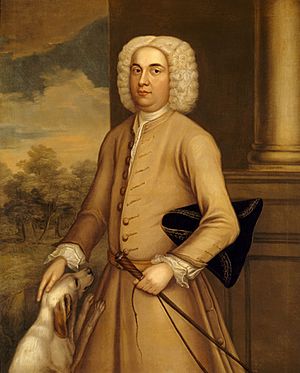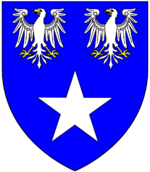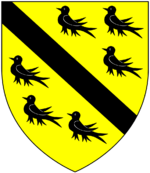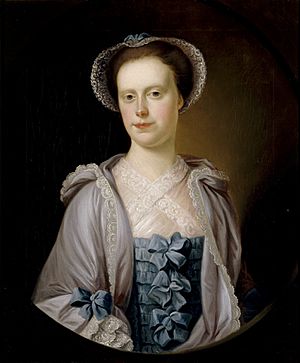Henry Fownes Luttrell (died 1780) facts for kids
Henry Fownes Luttrell (born Henry Fownes; c. 1722 – 30 October 1780) was an important person from Dunster Castle in Somerset, England. He was like a local leader, serving as the High Sheriff of Somerset from 1754 to 1755. He was also a Member of Parliament (MP) for the area of Minehead from 1768 to 1774. This meant he helped make laws for the country.
Henry Fownes was the son of John Fownes. His family lived at Nethway and Kittery Court, near Dartmouth. He grew up living the life of a country gentleman, often called a "squire."
In 1747, Henry married Margaret Luttrell. Margaret was the only child who would inherit Dunster Castle. To follow her late father's wishes, Henry added his wife's family name, Luttrell, to his own. This is how he became Henry Fownes Luttrell.
At that time, when a woman married, her husband legally owned all her property. So, Henry became the owner of Dunster Castle and other lands. He made many changes to the castle, updating its inside and the surrounding park. He also built the Conygar Tower, which was a decorative building (a folly) in the castle grounds. After Margaret died in 1766, he married again in 1771.
Contents
Life and Family
Henry Fownes was born around 1722 or 1723. His father was John Fownes, who was also a Member of Parliament for Dartmouth. Henry's family had been important in Devon for a long time.
Marriages and Children
Henry Fownes Luttrell married twice:
- His first marriage was on 16 February 1747, to Margaret Luttrell (1726–1766). She was the daughter of Alexander Luttrell, whose family had owned Dunster Castle since 1376. Their marriage was very happy. After marrying Margaret, Henry had to add "Luttrell" to his name and live at Dunster Castle for six months each year.
- Henry and Margaret had six sons and four daughters. Sadly, several of their children died when they were babies. Their children who survived were:
- John Fownes Luttrell (1752–1816). He also became a Member of Parliament for Minehead.
- Rev. Alexander Luttrell (born 1754; died 1816). He became a church minister.
- Francis Fownes Luttrell (1756–1823). He was also an MP for Minehead and later worked for the government's customs department.
- Thomas Fownes Luttrell (1763–1811). He was an army officer and an MP for Minehead.
- Lieutenant Henry Fownes Luttrell (1753–77). He was an officer in the army and died young.
- Margaret Fownes Luttrell (1747–92). She married John Henry Southcote.
- In 1771, five years after his first wife died, Henry married Frances Bradley (died 1803). She was from Dunster.
Life as a Country Gentleman
Henry Fownes Luttrell went to Queen's College, Oxford, but he didn't finish his degree. He preferred to live the life of a country squire.
When Margaret Luttrell's father died in 1737, she was only eleven. Her family had some debts, so Dunster Castle was closed for a while, and some family treasures were sold. Margaret went to live with her mother and stepfather, Edward Dyke. It was there that she met and married Henry Fownes.
Henry worked to improve his wife's family estate. He tried to sell some lands to help with money, but he couldn't find buyers. However, by spending carefully, he helped the estate recover. He also bought more land near Dunster. In his free time, Henry loved hunting with his dogs and horses, and he also enjoyed cockfighting.
Dunster Castle Changes
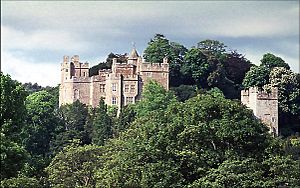
Starting in 1747, Henry Fownes Luttrell made many big changes to Dunster Castle. He redecorated and redesigned parts of it in a popular style called Rococo. He updated rooms like the Great Parlour and created new ones, such as a Drawing Room and a Breakfast Room. He also changed the Great Staircase. He was known for using new and fashionable wallpaper in the castle.
Henry also made big changes to the castle grounds. He created a large park and built the Conygar Tower. This tower was finished in 1775 and was designed to look pretty and improve the views from the castle. He also built a gatehouse and a statue of Neptune in the woods. He had the Dunster Water Mill and a nearby bridge rebuilt. The lower part of the castle was also changed, and some walls were removed. He created a large park of about 141 hectares (about 350 acres) south of the castle, which meant some farmers had to move.
Becoming a Member of Parliament
Being the Lord of the Manor of Minehead usually meant Henry Fownes Luttrell had a lot of power to influence who was elected to Parliament from that area. However, the Luttrell family had lost some of this control. In 1747, his agent warned him that he wasn't sure of many votes.
In the 1754 election, Henry couldn't run for MP because he was the High Sheriff of Somerset. So, a merchant named Henry Shiffner ran in his place. But Shiffner lost. A powerful local landowner, Lord Egremont, supported his own candidate, and another MP tried to sell parts of his land to gain support.
Henry Fownes Luttrell was upset, but he eventually made a deal with Lord Egremont. They agreed that each of them would support one candidate for the two parliamentary seats in Minehead, and they would work together against anyone else. Henry worked hard for seven years to gain more control over the votes in Minehead. This helped Shiffner get elected in 1761. During this time, Henry entertained voters at Dunster Castle with expensive feasts.
After his wife died in 1766, Henry decided to run for MP himself in the 1768 election. Even with his efforts, there was still some opposition. To gain more power, he went to London and got control over government offices in Minehead. This stopped his opponents from doing the same. Henry won the election, but it cost him a lot of money.
While he was an MP, Henry Fownes Luttrell didn't speak much in Parliament. He seemed to prefer his life as a country gentleman, enjoying his hunting and managing his estates. The Prime Minister, Lord North, thought Henry had promised to support the government's candidate, Thomas Pownall, in the next election. In 1774, Henry was elected again, this time alongside his eldest son, John. This caused a disagreement with Lord North. Henry eventually agreed to step down in favor of Pownall, but only if Pownall promised to ask for his permission before supporting anyone else in the future.
Even though he resigned, Henry Fownes Luttrell had made sure his family controlled both parliamentary seats for Minehead. His sons and grandsons continued to be MPs for Minehead for many years, until the system changed with the Reform Act of 1832.
Death
Henry Fownes Luttrell died on 30 October 1780.
Images for kids
| Parliament of Great Britain (1707–1800) | ||
|---|---|---|
| Preceded by Henry Shiffner The Earl of Thomond |
Member of Parliament for Minehead 1768–Dec. 1774 |
Succeeded by John Fownes Luttrell Thomas Pownall |
| Other offices | ||
| Preceded by John Macie |
High Sheriff of Somerset 1754–1755 |
Succeeded by Roger Lyde |


